

Mayor Nelda Martinez, Woman of Distinction
Corpus Christi Mayor Nelda Martinez was honored by the Texas Association of Mexican American Chambers of Commerce at the 4th annual Women of Distinction Awards in Austin.
Mayor Martinez was one of 12 Latinas from across the state that was recognized for their professional accomplishments, community contributions, and leadership. “I am humbled and honored to receive this recognition from such a prestigious state organization as The Texas Association of Mexican American…
Link to article
Joe Debro on racism in construction, Part 10: The Mexican American al laborer and entrepeneur(continued)
A 1968 book-length report, titled “A Study of the Manpower Implications of Small Business Financing: A Survey of 149 Minority and 202 Anglo-Owned Small Businesses in Oakland, California,” was sent to the Bay View by its author, Joseph Debro, prior to his death in November 2013, and his family has kindly permitted the Bay View to publish it. The survey it’s based on was conducted by the Oakland Small Business Development Center, which Debro headed, “in cooperation with the small businessmen of Oakland, supported in part by a grant, No. 91-05-67-29, from the U.S. Department of Labor, Manpower Administration, Office of Manpower, Policy, Evaluation and Research.” Project co-directors were Jack Brown and Joseph Debro, and survey coordinator was Agustin Jimenez. The Bay View is publishing the report as a series. A prolog appeared in the December 2013 Bay View, Part 1 in January 2014, Part 2 in February, Part 3 in April, Part 4 in May, Part 5 in June, Part 6 in August, Part 7 in October, Part 8 in November, Part 9 in January 2015 and this is Part 10 of the report…
Link to article
The Mexican Museum Hires Cayetana S. Gómez as President and Chief Executive Office
Gómez to oversee operations, capital campaign, cultural relations, and collections
SAN FRANCISCO, CA — January 27, 2015 — The Mexican Museum (Museum), the premier West Coast museum of Mexican, Mexican-American, Chicano, and Latino art, culture and heritage, announces that Cayetana S. Gómez has been hired as President and Chief Executive Officer (CEO). Gómez will be responsible for overseeing business operations for the Museum’s current location at Fort Mason Center. She will also be implementing the business and strategic plans for the cultural component of the 706 Mission Street Residential and Mexican Museum project, which will serve as the Museum’s future home in the heart of the Yerba Buena Gardens Art District.
“We are extremely pleased to have Cayetana join our team,” said Andrew M. Kluger, Chairman of The Mexican Museum Board of Trustees. “Along with her unparalleled communication skills and a vast network of professional relationships throughout the United States and Mexico, she has also held significant leadership positions for some of Mexico’s…
Link to article
Shumaker Loop names first Hispanic managing partner
Julio Esquivel, partner and a member of the management committee at Shumaker Loop & Kendrick LLP, is about to make history in the company.
Esquivel will be the firm’s next managing partner, taking over for J. Todd Timmerman, and will be the first Hispanic managing partner in the firm’s history.
Esquivel specializes in corporate law with a focus on mergers and acquisitions, securities, IPOs, franchise and distribution, and international transactions. He’s been a member of Shumaker Loop for 17 years, and said Partner Greg Yadley was his mentor from the start at the firm…
Link to article
Mexican professionals bringing ambition, startups to North Texas
Dallas Morning News
A cocktail mixer sponsored by the Association of Mexican Entrepreneurs …. “Americans respect power, and that’s what we’re striving for, economic …
Link to article
Slow and Steady Progress for Mexican American Professionals: The results of the American surveys for the years 2010-2012 show positive results
By Humberto Gutierrez
Edited by Kristen House
College enrollment showed an increase of 1.4 percent from 2010 to 2012—a positive sign for Mexican Americans wanting to achieve higher academic and professional goals. Here is the data.

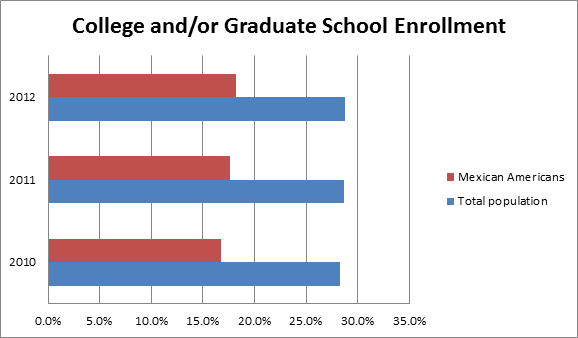
Educational attainment shows no change to the terrible numbers of 2.6 percent for the years 2010 and 2011 but there is hope in that 2012 showed a small gain to 2.9 percent.

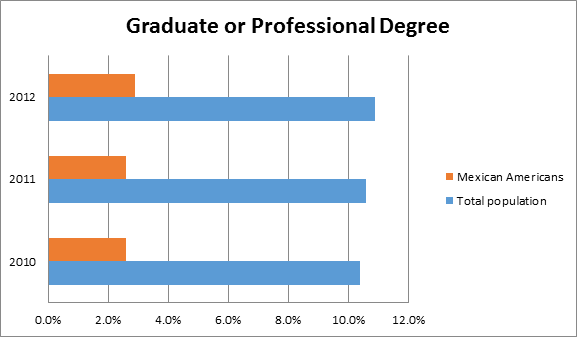
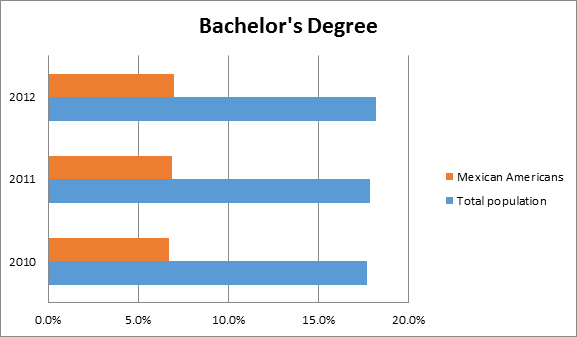
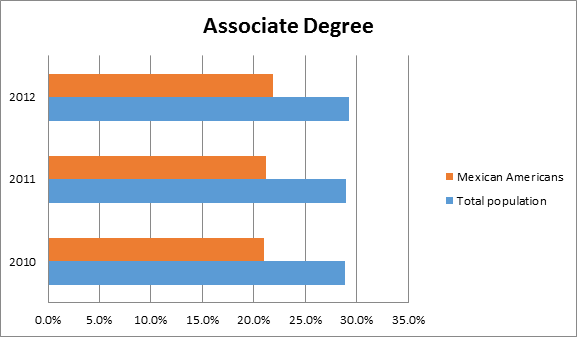
For occupations, there was a .2 percent increment yearly, but still shows that in management, business, science, and art occupations, there is still a wide gap between the total population at 36.1 percent for the year 2012 and 16.6 percent for Mexican Americans.

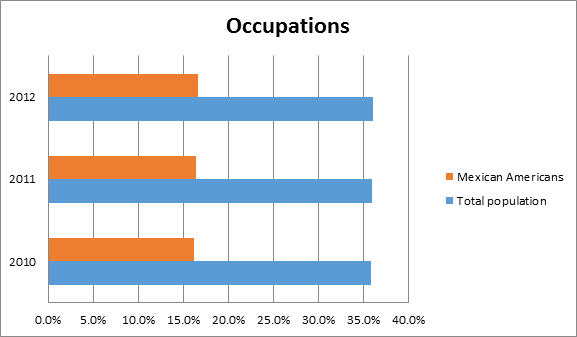
For professional, scientific, and management and administrative and waste management services, there is a close correlation between the percentage represented by the total population and Mexican Americans.

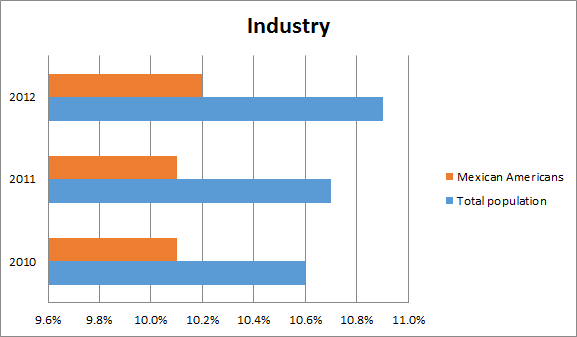
Summary:
There is hope at the end of the tunnel. College and university enrollment has been trending higher for Mexican Americans. Unfortunately, the percentage of students with graduate degrees stayed the same for the years 2010 and 2011, but rose a small amount in 2012. Percentages showing students with BA and AA degrees trended higher—an encouraging sign. Occupations still showed a wide margin between the total population and Mexican Americans. The Mexican American population showed a small increase in professional, scientific, and management and administrative and waste management employment while the total population showed a small but steady increase in this area.
References:
- Census Bureau, Selected Population Profile in the United States: 2010 – 2012
- United States S0201. Selected population Profile in the United States
- Population Group: Mexican and Total Population
- Data Set: American Community Survey 1-Year Estimates
Employment & Job News 2014: US Employers Hire 321,000 Employees in November; Latino Unemployment Drops Slightly
Employment & Job News 2014: US Employers Hire 321,000 Employees in November; Latino Unemployment Drops Slightly
U.S. employers hired 321,000 people in November, the latest sign of steady growth and health job gains. The latest job figures mean 2014 is on track to be the strongest year for hiring since 1999, and 10 million jobs were lost during the financial crisis in 2008.
More jobs, 44,000, were added in September and October than had previously been estimated. The Department of Labor said the unemployment rate remained at a six-year low of 5.8 percent.
Economy analysts say job gains will accelerate improvement in the labor market as more industries participate in the recovery. The Labor Department measured a 69.7 percent rate increase in its Diffusion index which measures industry payrolls…
Link to article
Hopeful Gains in Higher Education for Mexican Americans
By Humberto Gutierrez
Edited by Kristen House
The latest figures from the 2013 American Community Survey show progress in the wide gap between the total US professional population and Mexican Americans:
- 2012 college and/or graduate enrollment was 28.8% for the total population but only 18.2% for Mexican Americans.
- 2013 college and/or graduate enrollment was 28.3% for the total population, 18.1% for Mexican Americans, and 33.3% for foreign-born Mexican Americans.
College enrollment for the total population has decreased from the years 2012 to 2013 by 463,000 according the Census Bureau as stated in their Sept. 24, 2014 press release.
For Mexican Americans, there was also an enrollment decrease, but not as pronounced. Mexican American enrollment dropped by only .1% whereas for the total population, there was a .5% drop in college enrollment.
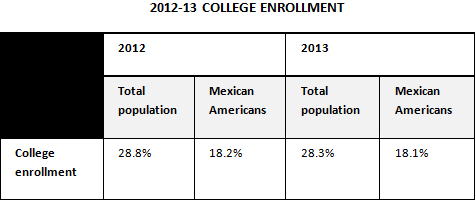
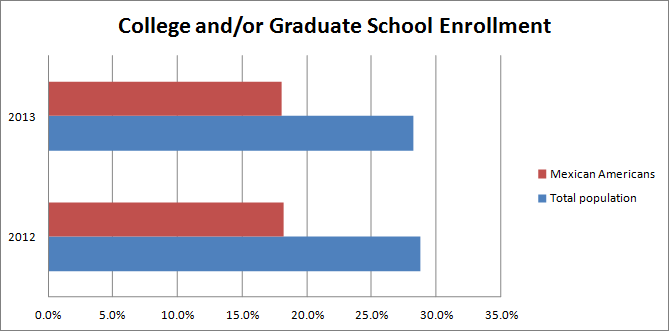
EDUCATIONAL ATTAINMENT
Educational attainment for the general population has risen by .3% from the years 2012 to 2013. For Mexican Americans, it has decreased by .1%
Earned bachelor’s degrees for the general population have risen by .2% and a bit more for Mexican Americans at .3%
Associate degrees and/or some college has shown little change across the board.
Unfortunately, only 2.8% of Mexican Americans and 1.5% of foreign-born Mexican Americans completed a graduate or professional degree in 2013. This is an extremely low percentage because the total population completion of a graduate or professional degree in 2013 was 11.2%. Why are Mexicans and native-born Mexicans not obtaining their graduate degrees? While only 7.3% of Mexican Americans have B.A. degrees, many are settling for associate degrees—21.8% of Mexican Americans and 12.1% of foreign-born Mexican Americans are ending their academic careers upon achieving these two-year degrees, according to the 2013 data.
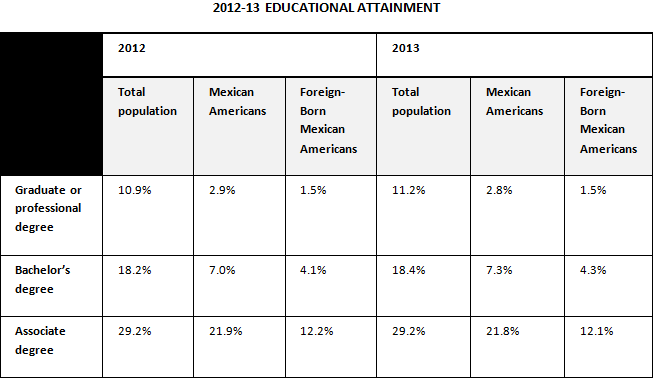
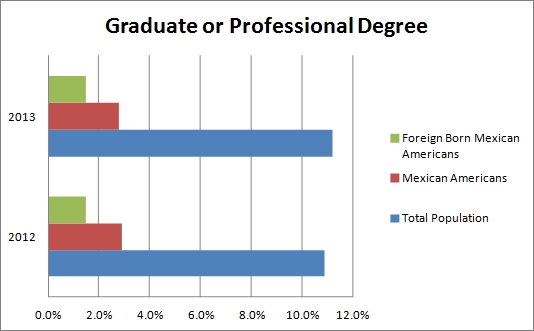
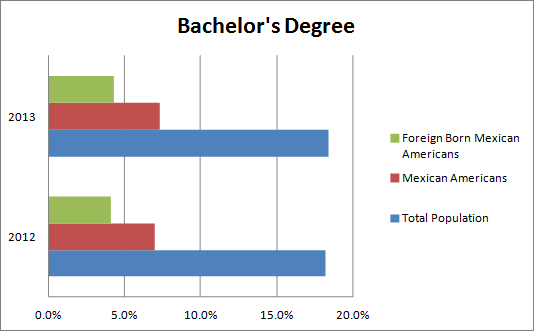
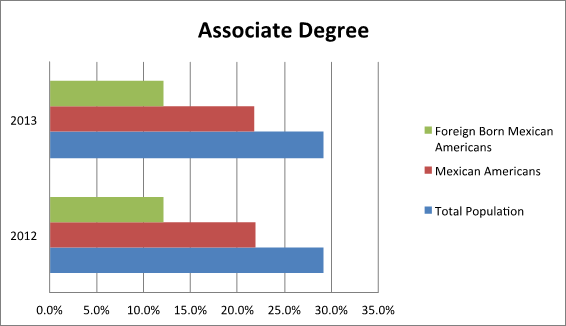
OCCUPATIONS
For the year 2013, the data for civilian employed population 16 years and over in management, business, science, and arts occupations is: 36.3% for the total population, 16.7% for Mexican Americans, and 9.2% for foreign-born Mexican Americans. Again, dismal figures.
Compared to the 2012 results, which were for the total population of 36.1% and for Mexican Americans 16.6%, there was a .2% increase for the total population and .1% for Mexican Americans. There was also a .2% increase for foreign-born Mexican Americans. Not much change, but some hope.
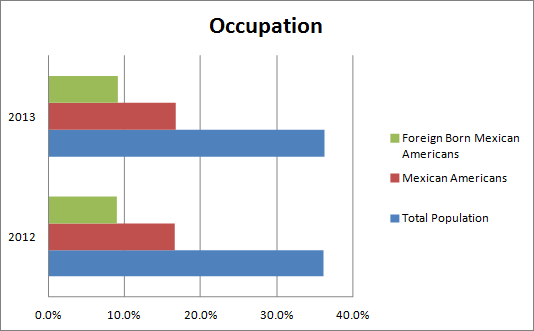
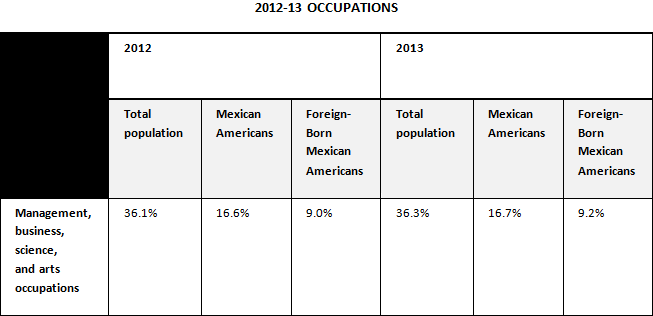
INDUSTRY
For professional, scientific, management and administration, and waste management services, 2013 employment for the total population was 11.1% and 10.2% for Mexican Americans, with foreign-born Mexican Americans at 11.5%. The 2012 results were for the total population 10.9% and 10.2% for Mexican Americans with the foreign-born Mexican Americans at 11.6%. No change for Mexican Americans and a .2% increase for the total population. However, a happy surprise: in 2013, foreign-born Mexican Americans topped all groups at 11.5% with a small decrease from 2012.
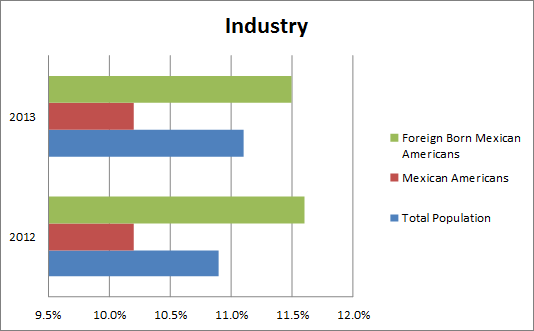
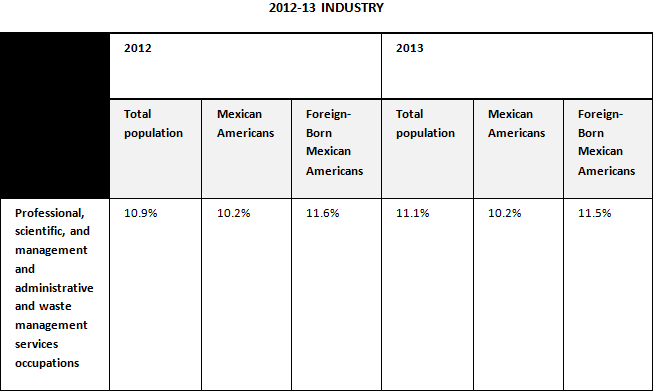
This represents a mixed picture for Mexican Americans and for foreign-born Mexican Americans in their quest for parity with the total population.
Solution for Retaining Minority Students in Higher Education
Scott Watson Swail’s 2003 report (1) on student retention programs in higher education states that a comprehensive student retention program should:
- rely on proven research
- suit the particular needs of the campus
- be institutionalized and become a regular part of campus service
- involve all campus departments and all campus personnel
- take into consideration the dynamics of the change process and provide extensive and appropriate retraining of staff
- be student centered
- operate in a cost-effective way, and not be tied to soft monies
- have the support of a comprehensive student monitoring system that will become the foundation of all institutional research on campus and support every department
- be sensitive to student needs and to diverse populations.
At least some of the above recommendations would go a long way to encourage many minority students to continue their higher education by obtaining a graduate or professional degree.
Berkley, Stanford, UCLA, and Caltech collaborate to boost minority Ph.D. students by recruiting underrepresented students in mathematical, physical and computer sciences, and in engineering.
UC Berkley put it best: “The four schools are creating a unique, cross-institutional community of underrepresented minority Ph.D. students, postdoctoral scholars, and faculty members in the targeted fields; developing faculty training to better recognize and help these students thrive and advance; and conducting research that includes annual surveys of Ph.D. students about what factors impact their attitudes, experiences and preparation for the future.”(2)
References
- Census Bureau, Selected Population Profile in the United States: 2012 and 2013
- United States S0201 and B 05006. Selected population Profile in the United States
- Population groups: Mexican and Mexico (foreign-born)
- Data set: American Community Survey 1-Year Estimates for years 2012 and 2013.
- Census Bureau, American Fact Finder, Selected population Profile in the Untied States.
————————————————–
(1) Watson Scott Swail, Retaining Minority Students in Higher Education: A Framework for Success, George Washington University, 2003
(2) Gretchen Kell, “Berkeley, Stanford, UCLA, Caltech unite to boost number of minority Ph.D. students, faculty,” UC Berkley News Center, February 13, 2014
Latinos moving up to own, run farms
WATSONVILLE, Calif. — When he was 15, an immigration raid at a Japanese flower nursery turned Arturo Flores’ life around. The owners needed a new group of workers to replace the ones removed by immigration officials, and Flores landed a job cutting flowers.
He slowly worked his way up to packaging and delivering them. In the mid-1980s, he got a call from two businessmen looking to start their own cut-flower business. They asked him to manage deliveries and distribution. Today Flores, 50, is the president of Central California Flower Growers in Watsonville, a distributor in Santa Cruz County that sells more than 100 varieties of flowers and other plants…
Link to article
The Population With a Bachelor’s Degree or Higher by Race and Hispanic Origin: 2006–2010
This report examines people aged 25 and over with a bachelor’s degree or higher among racial and Hispanic-
origin groups. As the U.S. population becomes more racially and ethnically diverse, it is important to exam-
ine educational attainment among population groups,which is a strong predictor of economic well-being.
Also, government agencies require data on educational attainment for funding allocations and program plan-
ning and implementation, while local government use information on educational attainment to attract
potential employers to their areas…
Link to report
American-Mexican Company Builds Bridge to Help US Small Businesses Exhibit at Trade Shows in Mexico City
Expo Solutions Mexico is a logistics coordination service offering American small businesses a budget friendly solution to exhibiting at trade shows in Mexico City.
Minneapolis, MN, August 13, 2014 –(PR.com)– New Company creates a bridge for small U.S. businesses on a budget wishing to do trade shows in Mexico.
The new logistics coordination service company offers financially smart solutions for small businesses who want to expand into the Mexican market by exhibiting at trade shows. The service offers logistics coordination and a concierge service for the visiting business executives. The objective of the services is to save time, money, worry and risk, allowing the visiting business…
Link to press release
Mexican-American To Coordinate Care Immigrants, Undocumented Children In Chicago
Mexican-American Tonantzin Carmona, 24, has assumed the management of the Office of New Americans at Chicago City Hall, which provides needed aid to immigrants and will coordinate shelter in this city for 1,000 undocumented Central American children.
The young woman replaces another Mexican, Adolfo Hernandez, who was the first director of this office, founded by Mayor Rahm Emanuel soon after he was elected, with the mission of making Chicago the best city in the world…
Link to article
Yahoo Diversity Figures Show Lack of Blacks, Hispanics
Yahoo has released information on the diversity of its workforce, and like Google it has a lot of room for improvement.
Last month, Google revealed that only 2% of its workforce was Black, 3% Hispanic and women only 30%.
Yahoo has followed suit by publishing its workforce diversity figures, and they are along the same lines. Women make up 37% of the overall workforce, with blacks representing 2% and Hispanics 4%.
In leadership positions at Yahoo (defined as VP and above), the story is even more lopsided. 77% of those posts are held by men, 2% are held by Hispanics and only 1% by Blacks…
James J. Lorence. Palomino: Clinton Jencks and Mexican-American Unionism in the American Southwest.
BD Behnken – The American Historical Review, 2014
… The union soon transferred him to New Mexico, where local Mexican American leaders such
as Juan Chacón were already involved in a bitter … The jury found Jencks guilty of perjury based
largely on the testimony of FBI informant and professional liar Harvey Matusow, who …
Link to review
Latino Winemakers Rise in California, Through the Ranks
SONOMA, Calif. — It is harvest season in wine country, the time of year when the scent of crushed grapes infuses the air and flatbed trucks heavy with fruit cargo come lurching down narrow back roads…
Link to article
A Demographic Portrait of Mexican-Origin Hispanics in the United States
A record 33.7 million Hispanics of Mexican origin resided in the United States in 2012, according to an analysis of Census Bureau data by Pew Research Center. This estimate includes 11.4 million immigrants born in Mexico and 22.3 million born in the U.S. who self-identified as Hispanics of Mexican origin.
by Ana Gonzalez-Barrera and Mark Hugo Lopez
Mexican-Origin Hispanics in the United States
Link to article
Northrop Grumman engineer named Woman of the Year by Mexican American group
Ana Luisa Ramirez, a system engineering manager in the Intelligence, Surveillance, Reconnaissance and Targeting Systems Division at Northrop Grumman in Linthicum, has been named Woman of the Year by the Mexican American Opportunity Foundation.
She received the honor in recognition of her professional achievements and service to the Hispanic community. At Northrop Grumman, Ramirez leads the systems engineering integration and test function for an international program.
Link to article
Clinton Jencks and Mexican-American Unionism in the American Southwest
JJ Lorence – 2013
… process, I have been fortunate to work with the skilled editors at the University of Illinois Press,
whose professional guidance was … The University of Illinois Press granted permission to reprint
portions of “Mexican American Workers, Clinton Iencks, and Mine-Mill Social Activism in …
Link to book
RESULTS OF THE AMERICAN COMMUNITY SURVEY FOR 2011: a comparison of the results for the years 2010 and 2011 contrasting the total population of the United States and Mexican American professionals
By HUMBERTO (TITO) GUTIERREZ
Edited by Corrie Cripps
Mexican American women have been making slow but steady gains in business, science and art management jobs over the past few years, according to statistics from the 2011 American Community Survey conducted by the U.S. Census Bureau. However, Mexican American professionals continue to be underrepresented among the total U.S. professional population. This brief identifies areas of interest in the 2011 American Community Survey to Mexican American professionals.
Note: The statistics in this brief refer to the population who reported themselves as Mexican Americans on the American Community Survey.
According to the Survey, the total population of the U.S. is 311,591,919.
The Mexican American population is 33,557,922, roughly 10.8% of the total U.S. population.
College and/or Graduate School Enrollment
- 28.3% of the total population was enrolled in college or graduate school in 2010. In 2011, this number increased to 28.7%.
- 16.8% of the Mexican American population was enrolled in college or graduate school in 2010. In 2011, this number increased to 17.6%.
Charts: Total population enrolled in college and/or graduate school, Total U.S. population vs. Total Mexican American population
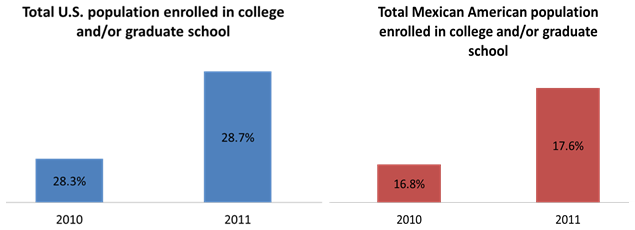
Educational Attainment:
- 17.7% of the total population earned bachelor degrees in 2010. In 2011, this number increased to 17.9%.
- 6.7% of the Mexican American population earned bachelor degrees in 2010. In 2011, this number increased to 6.9%.
- 10.4% of the total population earned graduate and professional degrees in 2010. In 2011, this number increased to 10.6%.
- 2.6% of the Mexican American population earned graduate and professional degrees in 2010, and this percentage remained the same in 2011.
Table: Educational attainment, bachelor degrees or higher
Note: In the following chart, each statistic stands for itself, i.e. do not add the male percentage to the female percentage to get a total.
Persons with a bachelor’s degree or higher are those who have received a bachelor’s degree from a college or university, or a master’s, professional, or doctorate degree.
| 2010 | 2011 | |||
| Total Population | Mexican American | Total Population | Mexican American | |
| Graduate or professional degree | 10.4% | 2.6% | 10.6% | 2.6% |
| Bachelor’s degree or higher | 28.3% | 16.8% | 28.7% | 17.6% |
| Males with bachelor’s degree or higher | 28.5% | 8.4% | 28.7% | 8.6% |
| Females with bachelor’s degree or higher | 27.9% | 10.4% | 28.3% | 10.6% |
OCCUPATIONS
Note: this data in this section includes only persons 25 years of age and older. The percentages are obtained by dividing the counts of graduates by the total number of persons 25 years old and over.
Occupations: Female employed civilians, age 25 and older:
- 39.4% of the total population of women in 2011 were employed in management, business, science, and arts occupations. Mexican American women represent 22.1% of the Mexican Americans employed in management, business, science, and arts occupations.
- Between 2007 and 2011, there has been a 1.7% increase (20.4% to 22.1%) in the number of Mexican American women employed in management professional and related occupations. In this area, the female general population figure has increased from 37.9% in 2007 to 39.5% in 2011, a 1.6% increase.
Occupations: Male employed civilians, age 25 and older:
- Between 2007 and 2011, there has been a 1.7% increase in the number of Mexican-American males in management and professional occupations.
Table: Occupations, Civilian employed population, age 25 and older
| 2010 | 2011 | |||
| Total Population | Mexican American | Total Population | Mexican American | |
| Management, business, science, and arts occupations | 35.9% | 16.2% | 36.0% | 16.4% |
| Males in management, business, science, and arts occupations | 32.8% | 12.4% | 32.7% | 12.5% |
| Females in management, business, science and arts occupations | 39.4% | 21.7% | 39.5% | 22.1% |
Industry: Civilian employed population 16 years and older:
- 10.6% of the general population was employed in the professional, scientific, management, administrative and waste management services in 2010. In 2011, this number only increased by .1% to 10.7%.
- 10.1% of Mexican Americans were employed in the professional, scientific, management, administrative and waste management services in 2010. In 2011, this percentage remained the same.
Public Administration:
- In 2010, the total population was 5.2% in public administration and 3.5% for Mexican Americans.
- In 2011, the total population was 5.1% in public administration and 3.4% for Mexican Americans. As with the Industry statistics, there was virtually no change from 2010 to 2011 in this area.
SUMMARY
Comparison of the 2010 and 2011 ratios of professionals in the general population and in the Mexican American population shows little change. In general, graduate and professional degrees among the total population are more than triple when compared with Mexican Americans who have earned graduate or professional degrees. On the bright side, there is at least one area where the ratio is almost equal; women have, again, gained ground in business, science and art management.
Reference Documents from the U.S. Census Bureau, American Community Survey
- Census Bureau, Selected Population Profile in the United States: 2011 (a PDF file)
- United States S0201. Selected Population Profile in the United States (search page)
Population Group: Mexican
Data Set: American Community Survey 1-Year Estimates (for years 2007, 2010, and 2011) - United States S0201. Selected Population Profile in the United States (search page)
Population Group: Total Population
Data Set: American Community Survey 1-Year Estimates (for years 2007, 2010, and 2011)
Value of Education as Perceived by Mexican Immigrants and Caucasian American Citizens Employed in Agriculture in Louisiana
R Johnson, J Kotrlik
… A panel of extension aquaculture professionals examined the instrument for face and construct
validity. Two pilot tests were conducted. … doi:10.1111/j.1365- 2206.2010.00682.x Batalova, J.,
& Lowell, B. (2007). Immigrant professionals in the United States. …
Link to article


